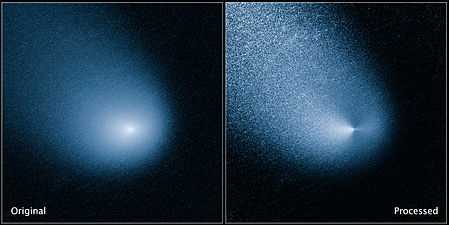2013 FY27
| Discovery[1] | |
|---|---|
| Discovered by |
Scott Sheppard Chad Trujillo Cerro Tololo Inter-American Observatory (807) |
| Discovery date |
17 March 2013 announced: 31 March 2014 |
| Designations | |
| MPC designation | 2013 FY27 |
| TNO, SDO[2] | |
| Orbital characteristics[3] | |
|
Epoch 2013-Jul-24 (Uncertainty=8)[3] | |
| Aphelion | 82.6 ± 4 AU (Q) |
| Perihelion | 35.7 ± 1.3 AU (q) |
| 59.1 ± 2.9 AU (a) | |
| Eccentricity | 0.396 ± 0.05 |
| 455 ± 33 yr | |
| 214 ± 55° (M) | |
| Inclination | 33.13 ± 0.02° |
| 187.04 ± 0.02° | |
| 137 ± 26° | |
| Physical characteristics | |
| Dimensions |
752 km (Brown)[4] 530[lower-alpha 1]–1100[lower-alpha 2] km[3][5] 900 km[6] |
| Albedo |
0.1 to 0.4? (assumed range) 0.15 (theoretically expected value)[4] |
| 22.1 | |
|
3.0 (JPL/MPC)[3] 3.3 (Brown)[4] | |
|
| |
2013 FY27, also written 2013 FY27, is a trans-Neptunian object[3] that belongs to the scattered disc (like Eris).[6] Its discovery was announced on 31 March 2014.[1] It has an absolute magnitude (H) of 3.0,[3] which makes it very likely to be a dwarf planet.[4] Assuming an albedo of 0.15, it would be approximately 850 kilometres (530 mi) in diameter.[5] It is the ninth-intrinsically-brightest known trans-Neptunian object.[7]
2013 FY27 will come to perihelion around 2198,[lower-alpha 3] at a distance of about 36 AU.[3] It is currently near aphelion, 80 AU from the Sun, and, as a result, it has an apparent magnitude of 22.[1] Its orbit has a significant inclination of 33°.[3]
First observed on 17 March 2013, it has an observation arc of about one year.[3] It came to opposition in early March 2014.
The sednoid 2012 VP113 and the scattered-disc object 2013 FZ27 were discovered by the same survey as 2013 FY27 and were announced within about a week of one another.
Notes
References
- ↑ 1.0 1.1 1.2 "MPEC 2014-F82 : 2013 FY27". IAU Minor Planet Center. 2014-03-31. Retrieved 2014-03-31. (K13F27Y)
- ↑ "List Of Centaurs and Scattered-Disk Objects". Minor Planet Center. Retrieved 2014-04-02.
- ↑ 3.0 3.1 3.2 3.3 3.4 3.5 3.6 3.7 3.8 3.9 "JPL Small-Body Database Browser: (2013 FY27)" (last observation: 2014-03-26; arc: 1.02 years). Jet Propulsion Laboratory. Retrieved 2014-03-31.
- ↑ 4.0 4.1 4.2 4.3 Mike Brown, How many dwarf planets are there in the outer solar system? (assumes H = 3.3)
- ↑ 5.0 5.1 Dan Bruton. "Conversion of Absolute Magnitude to Diameter for Minor Planets". Department of Physics & Astronomy (Stephen F. Austin State University). Retrieved 2014-03-26.
- ↑ 6.0 6.1 Lakdawalla, Emily (2014-04-02). "More excitement in the outermost solar system: 2013 FY27, a new dwarf planet". Planetary Society blogs. The Planetary Society. Retrieved 2014-04-02.
- ↑ "JPL Small-Body Database Search Engine: orbital class (TNO) and H < 3.1 (mag)". JPL Solar System Dynamics. Retrieved 2014-03-31.
External links
- Orbital simulation from JPL (Java) / Horizons Ephemeris
- Celestia Files of the recent Dwarf Planet finds (Ian Musgrave: April 6, 2014)
- Gaggle of dwarf planets found by dark energy camera (Aviva Rutkin: 2 April 2014)
| ||||||||||||||||||||||
| ||||||||||||||
| |||||||||||||||||||||||||||||||||||||||||


